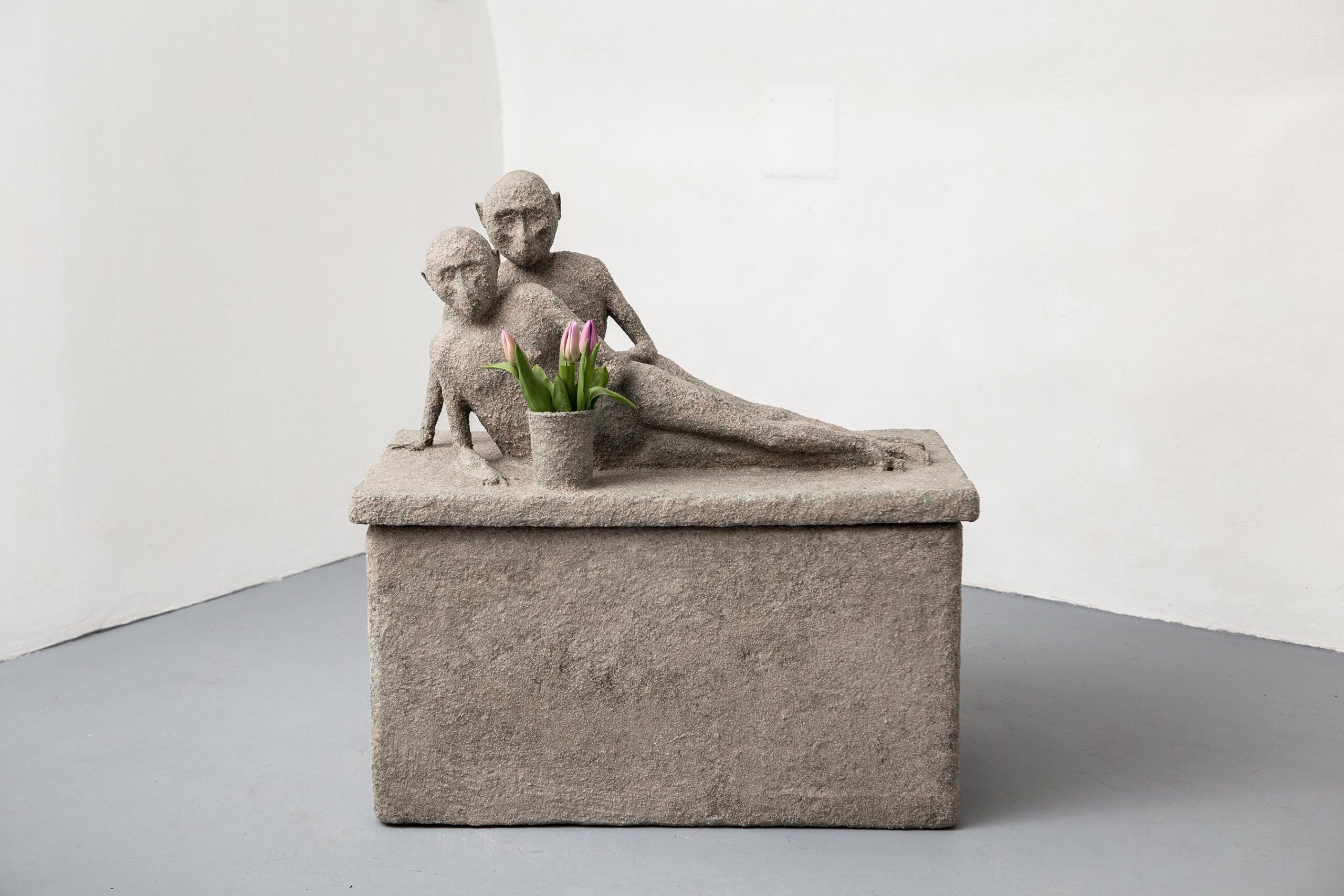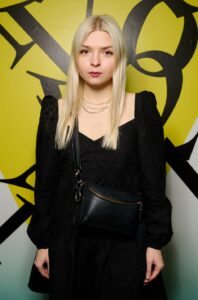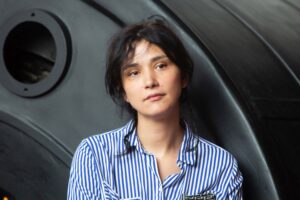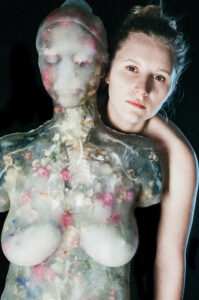Kata Tranker
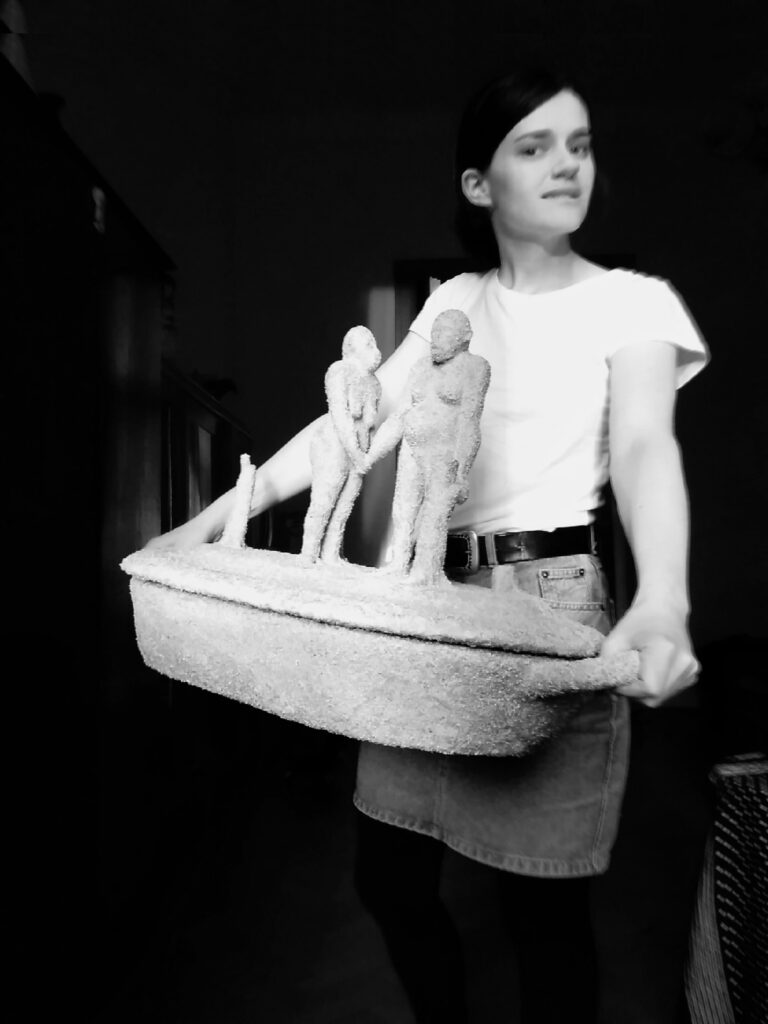
– born in 1989 – studied painting at the Hungarian University of Fine Arts and media design at the Hochschule für Angewandte Wissenschaften in Hamburg. Her installations built from small elements, her carefully shaped objects and detailed, delicate collages investigate the eternal questions of the individual and society, and the existentialist problems of the subject. She realizes conceptual installations with cheap, ephemeral materials, while also boldly experimenting with different techniques. Paper and wood are the recurring elements of her works, and she likes to complete them with found objects, books, everyday tools and archival photos. Balancing between plane and space, her compositions give an impression of fragility, vulnerability and relativity. While Tranker’s art is characterized by a personal tone that revolves around the concepts of identity search, self-reflection and intimacy, her works based on free associations express the universal truths and principles of knowledge and cognition.
If I think that I am connected in many respects to the institutional system that we identify here and now as art sphere, then I can declare that I am an artist. Yet I don’t really believe in the existence of ‘artists’. For the sake of simplicity, I use this term for self-determination and only when speaking with others, but in regard to my own identity, this concept means nothing.
In the global system, I can still be an artist, although less interesting as my points of connection are fewer; I don’t live in the centre and didn’t even study there, but in the so-called semi-peripheral part of the periphery which isn’t even exotic enough.
The fact that I am a woman and a mother makes my situation worse. The art world is the least tolerant towards motherhood (but tolerates all other deviances very well). Perhaps because there is too much contrast between the image of an artist who sacrifices everything for his art and that of a self-sacrificing mother1. And these two images are deeply burned into everyone.
In my early twenties, it was shocking to read statements from great female artists like Tracey Emin or Marina Abramović declaring that women have to give up motherhood if they want to be good artists. According to them, only male artists can afford to have children, women must choose between giving birth to a child or to build a career as an artist, and it is impossible to do both, as the child only prevents the artist from being detached from the world, out of everyday routine and reality2.
Over time, I decided that I don’t want to overcompensate for anything or rival the toughness of men, especially not on a scene that ideally, is not about competition. I would like to believe that we gradually move away from gender stereotypes every day, that it is less and less against something that we have to formulate our identity, and that taking on caring roles is no longer a sign of subordination.
When I became a mother and the image of the artist dictated by ‘art world’ faded away in an unreachable distance, I was struck by the fact that producing art had become the same work as any other, expecting one to self-exploit even more. After all, artists are expected to sacrifice everything for work, and isolate from the noise of the world in their studios (their concentration cannot even be disturbed by the voice of their own child)3, to constantly travel around the world for exhibitions, fairs, residencies and other professional programs, to show references, numbers, trends and trusted quality, similarly to a service or product. This comes as no surprise, since art has become an industry these days. It has everything an industry requires. And anyone who wants to stay away from this system or gets stuck outside of it is a ‘not a good artist’.
After all this, the most interesting to me are often the ‘not good artists’. Not just the outsiders or those who were pushed outside the canon, but the ones who are not even mentioned as artists, what’s more, their identities remain unknown. I am thinking of the Venus of Willendorf for example4. Who created it and why, nobody knows. Theories exist about it, but no one thinks it was created for the sake of art. (In contrast, art history books usually consider it as the beginning of sculpture.)
‘Les statues meurent aussi’ – Statues also die – as states Alain Resnais’s eponymous film, in which tribal objects are placed into a museum5. I am wondering if they can be resurrected? If we peel off the crusted layer that represents the art world, can they still breathe67?
My artistic practice often draws upon anthropological, primatological, zoological or science-fiction sources8. Examining the essence of art, observing human behaviour as well as today’s global events inevitably require to rethink the role of the human race. This is increasingly present in my life as well. In connection with motherhood, it has also become apparent to me that man is much more of an instinctive creature than he likes to think of himself. By perfecting our evolutionary strategies, we have reached the present eco-disaster through a chain of unsustainable processes, and are now facing it helplessly9. For this reason, I am strongly concerned with understanding the logic of human evolution, our gradual estrangement from the natural world and the various narratives that explain this process10. In my practice, studying biological and cultural developmental theories and the struggle for survival not only helps me understand the present, but allows to elaborate their possible development in the future11.
The statement was written in collaboration with art historian Viktória Popovics (2020).
1Image: Mother animal, 2020, paper pulp, crushed stone, 75 x 15 x 55 cm. Courtesy of the artist and VILTIN Gallery, Budapest.2Image: Mom with sick kid, 2018, paper pulp, crushed stone, 20 x 35 x 25 cm. Courtesy of the artist and VILTIN Gallery, Budapest
3Image: Mom with stroller, 2017, wood, 30 x 20 x 20 cm. Courtesy of the artist and VILTIN Gallery, Budapest.
4Image: Kata Tranker, Archive I., 2018, dough, wood, photo, resin, 25 x 35 cm, photo: Dávid Biró. Courtesy of the artist and VILTIN Gallery, Budapest.
5Image: Kata Tranker, Places of art: cave, church, museum, 2018, cardboard, photo, resin, pencil, dough, 50 x 70 cm, photo: Dávid Biró. Courtesy of the artist and VILTIN Gallery, Budapest.
6Image: Kata Tranker, Birth of Venus, 2018, installation (polyfoam, concrete, household items, paste, resin), 700 x 120 x 200 cm, photo: Dávid Biró. Courtesy of the artist and VILTIN Gallery, Budapest.
7Image: Kata Tranker, Birth of Venus, 2018, installation (polyfoam, concrete, household items, paste, resin), 700 x 120 x 200 cm, photo: Dávid Biró. Courtesy of the artist and VILTIN Gallery, Budapest.
8Image: Kata Tranker, Anthropological collection, 2017, paper, plasticine, photo, wood, pastel, 165 x 70 x 40 cm, photo: Simon Zsuzsanna. Courtesy of the artist VILTIN Gallery, Budapest.
9Image: Kata Tranker, Unaccounted perpetuity, 2017, installation (PET bottles, water, wood, paper, projection), 350 x 70 x 220 cm. Courtesy of the artist and VILTIN Gallery, Budapest.
10Image: Kata Tranker, Ancestors’ dish, 2020, installation (paper pulp, crushed stone, plasticine, acrylic), 200 x 350 x 160 cm, photo: Kunstverein Eisenstadt. Courtesy of the artist and VILTIN Gallery, Budapest.
11Image: Kata Tranker, Sarcophagus, 2020, paper pulp, broken stone, flowers, 85 x 48 x 100 cm, photo: Mátyás Gyuricza. Courtesy of the artist and VILTIN Gallery, Budapest.
– szül. 1989 – festő szakon végzett a Magyar Képzőművészeti Egyetemen, valamint tanult a hamburgi Hochschule für Angewandte Wissenschaften média design szakán. Apró elemekből építkező installatív munkái, gondosan megformált objektjei és részletgazdag, finom kollázsai az egyén és a társadalom örök érvényű kérdéseit, a szubjektum egzisztencialista problémáit feszegetik. Konceptuális installációi olcsó, efemer anyagokból épülnek fel, miközben a technikákkal is bátran kísérletezik. Munkáinak visszatérő eleme a papír és a fa, melyek talált tárgyakkal, könyvekkel, hétköznapi használati eszközökkel, archív fotókkal egészülnek ki. A sík- és a tér határmezsgyéjén egyensúlyozó kompozíciói a törékenység, a sérülékenység, a viszonylagosság hatását keltik. A Tranker művészetére oly jellemző személyes hangvétel az identitáskeresés, az önreflexió és az intimitás fogalmait járják körül, miközben szabad asszociációkon alapuló munkáiban a tudás és a megismerés univerzális igazságai, törvényszerűségei fejeződnek ki.
Ha arra gondolok, hogy számos ponton kapcsolódok ahhoz az intézményrendszerhez, amit itt és most a művészeti szférával azonosítunk, akkor kijelenthetem magamról, hogy művész vagyok. Pedig valójában nem hiszek abban, hogy léteznének ‘művészek’. Az egyszerűség kedvéért használom önmeghatározásra ezt a kifejezést, és mindig csak mások felé, a saját identitásom szempontjából viszont ez a fogalom nem jelent semmit.
A globális rendszerben még mindig művész lehetek, bár kevésbé érdekes, hiszen kevesebb a kapcsolódási pont, nem a centrumban élek, nem is ott tanultam, hanem a perifériának is csak az úgynevezett félperifériás részén, ami egzotikusnak sem elég egzotikus.
Helyzetemet tovább nehezíti az a tény, hogy nő és anya vagyok. A művészeti világ az anyasággal kapcsolatban a legkevésbé toleráns (minden egyéb devianciát jól megtűr). Talán azért, mert túl nagy az ellentét a művészetéért mindent feláldozó művész és az önfeláldozó anya képe között1. És ez a két kép mindenkibe mélyen bele van égetve.
Húszas éveim elején megrázó volt olvasni azokat a kijelentéseket olyan nagy, női művészektől, mint Tracey Emin vagy Marina Abramović, melyekben azt állítják, a nőknek le kell mondaniuk az anyaságról, ha jó művészek akarnak lenni. Szerintük csak a férfi művészek engedhetik meg maguknak, hogy gyerekük legyen, a nőknek választani kell, gyereket vagy művészetet szülnek, mindkettőt egyszerre nem lehet, hiszen a gyerek csak megakadályozza a művészt abban, hogy leválhasson a világról, kívül állhasson a hétköznapi rutinon és valóságon2.
Idővel aztán úgy döntöttem, én nem szeretnék semmit se túlkompenzálni, se a férfiak keménységével vetekedni, főleg nem egy olyan színtéren, ami ideális esetben nem a versenyről szól. Szeretném azt hinni, hogy minden nap sikerül távolabb kerülnünk a nemi sztereotípiáktól, identitásunkat egyre kevésbé valami ellenében kell megfogalmaznunk és a gondoskodó szerepek vállalása sem az alárendeltség jele már.
Amikor anya lettem és az ‘art world’ által elvárt művész képe elérhetetlen messzeségbe került, arra döbbentem rá, hogy a művészet előállítása mára ugyanolyan munkává vált, mint a többi, sőt valójában még több önkizsákmányolást szeretne kicsikarni az emberből. Hiszen a művészektől azt várjuk el, mindent feláldozva dolgozzanak a világ zajától elzárva műtermeikben (koncentrációjukban még a saját gyerekük hangja se zavarja meg őket)3, folyamatosan utazzanak a világ körül kiállításokra, vásárokra, ösztöndíjakra és egyéb szakmai programokra, hozzák a referenciákat, a számokat, a trendeket, a megbízható minőséget, akár egy szolgáltatás vagy termék. Nem csoda, hiszen a művészet manapság egy iparággá vált. Minden megtalálható benne, ami ehhez kell. Aki pedig ezen rendszertől távol akar maradni vagy kívül reked, az ‘nem jó művész’.
Mindezek után számomra a legérdekesebbek sokszor pont a ‘nem jó művészek’. Nem csak az outsiderek vagy azok, akik a kánon kívülre szorultak, hanem az olyanok, akiket művészként sem emlegetnek, vagy sőt mi több, kilétük teljesen homályos. Gondolok például a willendorfi vénuszra4. Semmit se tudni arról, ki és miért csinálta. Erről szóló elméletek vannak, de azt senki se gondolja, hogy a művészet kedvéért született volna. (Ehhez képest a művészettörténet könyvek rendszerint innen eredeztetik a szobrászatot.)
‘Les statues meurent aussi’ – a szobrok is meghalnak – ahogy Alain Resnais azonos című filmjében múzeumba kerülnek a törzsi tárgyak5. Engem az foglalkoztat, hogy vajon fel is támadhatnak? Ha lehámozzuk azt a megkérgesedett réteget, ami a művészeti világot jelenti, tudnak még lélegezni67?
Alkotói tevékenységem mögött inspirációként sokszor antropológiai, primatológiai, zoológia vagy tudományos-fantasztikus források állnak8. A művészet lényegének vizsgálata, az emberi viselkedés megfigyelése és napjaink világméretű eseményei kikerülhetetlenül megkövetelik az emberi faj szerepének újragondolását, mely egyre égetőbben van jelen az én életemben is. Az anyaság kapcsán vált nyilvánvalóvá az is számomra, hogy az ember sokkal inkább ösztönlény, mint amennyire azt magáról gondolni szereti. Evolúciós stratégiáink tökélyre fejlesztésével, fenntarthatatlan folyamatok láncolatán keresztül jutottunk el a jelen ökokatasztrófájáig, amellyel szemben tehetetlenül állunk9. Ebből kifolyólag erősen foglalkoztat az emberi evolúció logikájának felfejtése, valamint a természeti világtól való fokozatos eltávolodás és az erről alkotott különféle narratívák10. Művészetemben a biológiai és kultúrtörténeti fejlődéselméletek, a túlélésért folytatott küzdelem tanulmányozása egyrészt segíti a jelen megértését, másrészt lehetőséget ad a jövőre vonatkozó szcenárióik felvázolására11.
A statement Tranker Kata és Popovics Viktória művészettörténész együttműködésében jött létre (2020).
1Kép: Tranker Kata, Mother animal, 2020, papírpép, összetört kő, 75 x 15 x 55 cm. A művész és a VILTIN galéria jóvoltából.2Kép: Tranker Kata, Mom with sick kid, 2018, papírpép, összetört kő, 20 x 35 x 25 cm. A művész és a VILTIN galéria jóvoltából.
3Kép: Tranker Kata, Mom with stroller, 2017, fa, 30 x 20 x 20 cm. A művész és a VILTIN galéria jóvoltából.
4Kép: Tranker Kata, Archive I., 2018, tészta, fa, fotó, gyanta, 25 x 35 cm, fotó: Biró Dávid. A művész és a VILTIN galéria jóvoltából.
5Kép: Tranker Kata, Places of art: cave, church, museum, 2018, karton, fénykép, gyanta, ceruza, tészta, 50 x 70 cm, fotó: Biró Dávid. A művész és a VILTIN galéria jóvoltából.
6Kép: Tranker Kata, Birth of Venus, 2018, installáció (polifoam, beton, háztartási tárgyak, tészta, gyanta), 700 x 120 x 200 cm, fotó: Biró Dávid. A művész és a VILTIN galéria jóvoltából.
7Kép: Tranker Kata, Birth of Venus, 2018, installáció (polifoam, beton, háztartási tárgyak, tészta, gyanta), 700 x 120 x 200 cm, fotó: Biró Dávid. A művész és a VILTIN galéria jóvoltából.
8Kép: Tranker Kata, Anthropological collection, 2017, papír, gyurma, fotó, fa, pasztell, 165 x 70 x 40 cm, fotó: Simon Zsuzsanna. A művész és a VILTIN Galéria jóvoltából.
9Kép: Tranker Kata, Unaccounted perpetuity, 2017, installáció (PET-palackok, víz, fa, papír, vetület), 350 x 70 x 220 cm. A művész és a VILTIN Galéria jóvoltából.
10Kép: Tranker Kata, Ancestors’ dish, 2020, installáció (papírpép, összetört kő, gyurma, akril), 200 x 350 x 160 cm, fotó: Kunstverein Eisenstadt. A művész és a VILTIN Galéria jóvoltából.
11Kép: Tranker Kata, Sarcophagus, 2020, papírpép, összetört kő, virágok, 85 x 48 x 100 cm, fotó: Gyuricza Mátyás. A művész és a VILTIN Galéria jóvoltából.
